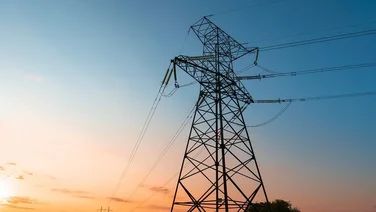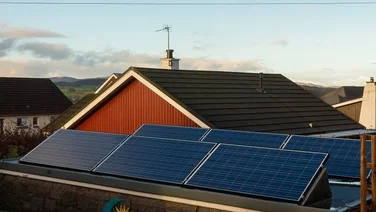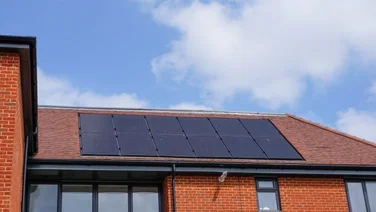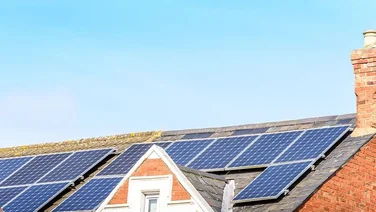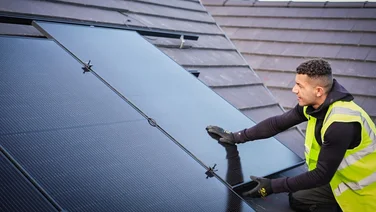- What does ‘off-grid’ actually mean?
- Is it possible to go off-grid in the UK?
- Is your property suitable for going off-grid?
- How to go off-grid in the UK
- How many solar panels are required to run a house off-grid?
- How much does it cost to go off-grid?
- Is it worth going off-grid?
- How many UK homes are actually off-grid?
- Next steps
- There are 150,000 off-grid homes in the UK
- It costs £42,000 to go off-grid, on average
- The most popular way to off-grid is to convert a van into a home
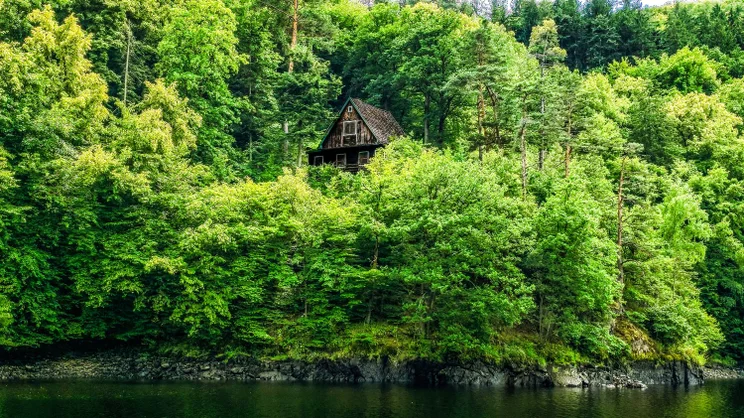
Although going off-grid is an expensive venture, it has a huge environmental impact and can be massively fulfilling. And by adding a battery to your off-grid setup, you’ll break even on the price of solar panels much faster.
There are also inevitable obstacles you’ll face, but if you’re wondering how to live off-grid in the UK with minimal difficulty, this guide can tell you everything you need to know.
If you want to find out how many solar panels your house would require to go off-grid, fill in this form to receive free quotes from trusted suppliers.
Where do you want to install solar panels?
Get startedWhat does ‘off-grid’ actually mean?
Off-grid homes exist with no connections to gas or electricity grids.
People who live in off-grid households supply their own heat and light from other sources.
Some rely on a supply of fossil fuels like coal, gas, and oil, others have built renewable systems involving solar panels, heat pumps, and wind turbines, and many use a mix.
Off-grid homes also often exist without connections to the national water and sewage services, or phone lines – though you can also go off-grid without moving to a remote location.
Some choose this lifestyle, while others are born into it.
Is it possible to go off-grid in the UK?
It’s definitely possible and legal to go off-grid in the UK, as shown by the tens of thousands of households currently living in this way.
And it’s getting easier. Nick Rosen, an expert in off-grid living who founded off-grid.net, told The Eco Experts: “It was much more difficult 20 years ago.
“Solar panels are better, camping gear is better, and mobiles and the internet – instead of cutting you off from civilisation – makes you more civilised by keeping you connected.”
You can purchase a plot of land and create your own home, buy a houseboat, or purchase a mobile home.
The biggest obstacle to going off-grid is financial, because setting up new sources of energy unavoidably costs a lot of money, whether in the short or long term.
But as long as you can afford the upfront cost of buying solar panels, storage batteries, and a heat pump – or the ongoing costs of coal, gas, and/or oil – it’s totally feasible. Check out: The 9 Best Solar Panels in the UK.
You can also spread the costs and difficulties by joining an off-grid community, or by teaming up with others to start one.
Is your property suitable for going off-grid?
You can go off-grid while living in a traditional house, but it depends on your specific property. You’ll need to use your home’s in-built advantages and probably cut your energy consumption.
You can also purchase a plot of land and build a more suitable home, or buy an alternative place to live, like a mobile home, houseboat, or shed.
Rosen said: “The easiest way to go off-grid is still on a boat.”
He added that relying on a mobile home is “difficult, because rules vary from one place to another, neighbours and neighbourhoods vary, and you’re very much at the mercy of local residents as to whether they want to complain or not.
“That’s not the case in many parts of Europe and the US, but it’s the biggest constraint in the UK.”
Whatever route you choose, you should properly insulate your home so you can significantly reduce your energy needs.
“The best way to go off-grid is to do so with your neighbours. If you set up a power supply with them, you’ll benefit from economies of scale, and hopefully spread the labour requirements too.”
How to go off-grid in the UK
You can go off-grid relatively easily in the UK, as long as you plan ahead and follow these steps.

Step 1: Choose your home and location
This can be the property you currently live in, an alternative home, or a house that you build yourself.
Your decision will of course largely be based on personal reasons, but make sure you consider the type and size of property you want, and the weather in the area.
It’s harder and more expensive to supply energy to a larger home, while a rural location will give you all the space you need to install renewable systems, but leave you without a community.To remedy this last point, you could pick a location where an off-grid community is established, or simply get your local community involved.
Rosen said: “The best way to go off-grid is to do so with your neighbours. If you set up a power supply with them, you’ll benefit from economies of scale, and hopefully spread the labour requirements too.”
Step 2: Analyse your energy consumption
Identify how much energy you use, and figure out ways to reduce that total.
You’ll need to either ensure your energy consumption is well below that of the average household, or be ready to pay huge amounts to continue using normal amounts of energy.
Rosen said: “Carry out an appraisal of your energy consumption, and analyse how to spread and reduce your energy consumption.
“You’ll become an energy detective, looking for the waste that you can get rid of.”
To those who are worried about changing how they live, Rosen said it was better to embrace an energy-conscious lifestyle now, as it’s inevitable.
“We keep being told we’re going to have to radically alter our lifestyles, but no-one knows how or when. By going off-grid, you put yourself on a path to radically alter your energy consumption.”
You might want to invest in tech that doesn’t require electricity, such as a solar oven, in order to help reduce your consumption.
Step 3: Figure out how you’ll get electricity
Use your home’s natural advantages to generate electricity in the most cost-effective way.
You could buy wind turbines if your property gets a lot of wind, solar panels if your roof has a good angle and direction to receive sunlight (20-50° and facing east, west, or ideally south), or a hydroelectricity system if you have a body of water on your land.
You can even combine some of these methods, which can help you to avoid the seasonal drop-off associated with solar and wind energy.
Step 4: Work out how you’ll get heat
Again, this largely depends on your home.
If you live somewhere relatively warm, you may want to use an air source heat pump, while a ground source heat pump could be the better choice if you live in the north and have a big garden.
Maybe you have a lake or stream next to your home, which would make a water source heat pump an excellent option.
If your plot of land comes with a large number of trees, you could cut down your own wood to use in a biomass boiler or open fire – though both are seriously bad for the climate.
You could also decide to rely entirely or partly on fossil fuels – but this will ultimately be more expensive in the long run, and you may fall foul of boiler bans in the near future.
Step 5: Pick backup energy options
Renewable options like wind and solar won’t always function at the exact intensity you want. The wind dies down sometimes, and the sun stops shining every night.
Even more consistent sources like ground or water source heat pumps can have issues, just like any machine can – including gas boilers.
For these moments, when you need energy you don’t have, it’s important to plan where you’ll get it from.
Depending on your situation, you may be able to keep your connections to the electricity and gas grids for this type of scenario.
Otherwise, decide what your backups will be – whether that includes a storage battery, diesel generator, or chopping more wood from your forest.

Step 6: Disconnect from the grid – if you want
Once your alternative energy sources are sorted, you can disconnect from the electricity and gas grids.
You could also stay connected and use these sources as a backup. It’ll cost you around £200 per year in standing charges to keep your electricity connection, and £100 to keep your gas connection.
To disconnect your electricity supply, contact the National Grid. The job will typically cost you £1,323 in England and £1,020, and take four to six weeks.
When it comes to gas, your energy supplier is responsible. Just get in contact, and the supplier will send someone to uninstall your gas meter and ensure your gas supply is capped.
Since the number of households disconnecting from gas is still low, you can often get this service for free.
There’s no need to ask for permission from any other authority.
Step 7: Take it slowly
There’s no need to rush. You can start the process by getting what Rosen called “off-grid ready,” which means taking steps that make you less reliant on the grid, such as buying solar panels, then a battery, then a heat pump.
As well as reducing your carbon footprint, going slowly means taking your comfort level into account at every step.
So if you’re most comfortable being partly off-grid – for instance by using the gas and electricity grids as a backup but trying not to use them – you don’t have to go any further.
You should also test out your theories about how you’ll reduce your energy usage before you implement them fully, to ascertain how you feel about each alteration.
How many solar panels are required to run a house off-grid?
It requires 16 solar panels to run the average family’s off-grid home.
This assumes you’re using a heat pump and solar battery, and that you’ve made a 40% reduction to both your electricity and heating consumption.
If you’d like to remain at the standard consumption levels for a three-bedroom house, it’ll typically take 26 solar panels to power your household.
However, the actual number will entirely depend on your energy consumption, whether you use other renewable sources – like wind – to supplement your supply, and whether you use electricity to fuel your heating system.
You can visit our solar panel costs page to get an idea of what you’ll pay for this kind of system.
And if you want to find out exactly how many solar panels your house would require to go off-grid, fill in this form to receive free quotes from trusted suppliers.
Do you need a solar battery?
In most cases, a solar battery is a good idea if you’re looking to go off-grid, unless you plan to make up the difference with a bigger wind turbine or other source of green electricity.
If you decide to get a battery, you’ll need a total of 12.8 kWh of solar battery storage, on average.
You could get two batteries to fulfil this need – one with around a 9 kWh capacity, and another with a 4 kWh capacity.
In total, solar battery storage will typically cost you £10,500.
To find out which storage you should get for your home, check out our guide to the best solar batteries.
Are there any other sources of electricity you can use?
There are a few other sources of electricity you can use apart from – or alongside – solar energy.
You can buy wind turbines, which dovetail well with solar panels, since they tend to generate the most energy during winter – when the sun shines the least.
You could also get a hydroelectricity system, if you have a body of water on your property. If well-installed, this can provide you with a consistent amount of electricity throughout the year.
And you can generate electricity with a generator, usually powered with petrol or diesel. This is best used as a backup option, since it’s very expensive and polluting to rely on.
How much does it cost to go off-grid?
It costs £42,000 to go off-grid in the UK, on average.
This total includes 16 solar panels, a wind turbine, and 13 kWh of solar battery storage, which will in most cases keep you supplied with electricity all year round.
Your solar batteries will help you to use 80% of the energy your solar panels generate, but it’s practically impossible to use 100% – at least in a cost-effective way.
That’s where the wind turbine comes in. If you get a 1.5 kW model installed on your land – for £8,500, on average – that should make up for the shortfall and give you a source of power when the sun doesn’t shine.
For heat, we’ve included the price of an air or water source heat pump – which are both available for £10,000, typically.
If you get a heat pump while the Boiler Upgrade Scheme is still active, you can get £7,500 off the cost of an air, ground, or water source heat pump.
If you get a ground source heat pump though, you’ll usually end up paying another £16,500-£41,500.
We’ve also factored in the cost of disconnecting your home from the grids, and assumed you’ll cut your electricity and gas usage by 40%, which is pretty standard for off-grid homes.
It may also cost you more to go off-grid if you buy a new plot of land or an alternative form of home, like a boat or mobile home, instead of staying in your current property.
Is it worth going off-grid?
It’s not worth going off-grid if your only goal is to save money – but in environmental terms, it’s one of the most fulfilling, impactful paths you can choose.
The average three-bedroom household will save £1,626 per year by completely eliminating its energy bills – a dream for many of us – but the upfront costs are steep.
With the typical household facing an outlay of £42,300, it’ll take 26 years to break even – and that’s in the unlikely situation that you won’t have to pay for any repairs.
And if you’re planning on buying a houseboat or a van, or if you intend to build a whole new home, that’ll obviously cost more.
But that’s unlikely to be your only motivation, or indeed your main one, so let’s analyse the impact you can have on the climate by going off-grid.
You can wipe out your energy-associated carbon footprint, removing 2.7 tonnes of CO2 per year from the atmosphere, on average.
You may well also shrink your footprint by changing your working patterns and consumption habits – for instance by commuting less or not at all, and by relying less on online shopping.
You may even choose to engage in environmentally positive pursuits like gardening, growing fruits and vegetables, and raising chickens, which will further reduce your footprint.
Residential emissions make up 16% of our national carbon footprint, and is the only major emissions category that hasn’t decreased since 2014 – so the more households that decide to go off-grid, the better.
If you want to escape the clutches of energy companies because you – like 48% of the country – no longer trust them, going off-grid is also a great way to gain your independence.
How many UK homes are actually off-grid?
Around 150,000 homes in the UK are fully off-grid, meaning they’re not connected to the gas or electricity grids – up from just 25,000 in 2007 – according to Rosen.
He added that “approximately 10,000 are conventional single-family houses – the rest are sheds, vans, boats, communes, fields, tents, etc.
“We estimate
[that includes]
18,000 boats, 30,000 sheds, and 70,000 converted vans.”
4.4 million homes are off the gas grid, relying mainly on heating oil, electricity, and solid fuel like wood or coal to keep them warm.
And up to 200,000 households aren’t connected to the electricity grid, either because they were missed out in the original roll-out in the 1960s and 70s, or because they choose to live off-grid.
Next steps
You now have all the information you need to start your off-grid journey.
If you don’t currently have a fixed plan, we recommend coming up with several different options, working out their costs, then making a decision about what works best for you.
And as soon as you’re ready to see how much it would cost to get solar panels for your new off-grid home, just fill in this form to receive free quotes from our trusted suppliers.

